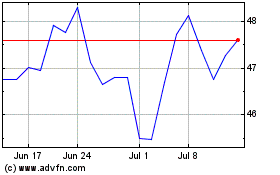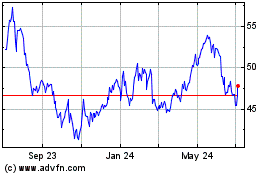Political Ad Spending Will Approach $10 Billion in 2020, New Forecast Predicts
June 04 2019 - 6:29AM
Dow Jones News
By Alexandra Bruell
Spending on political advertisements will hit a new high in
2020, surging $3.6 billion above the most recent presidential
campaign year.
Political ad spending will increase to $9.9 billion in 2020,
according to the latest U.S. ad forecast from WPP PLC's ad-buying
unit GroupM. That would be up from $8.7 billion in 2018, the year
of the most recent midterm Congressional elections, and $6.3
billion in 2016.
The growth between presidential campaign years is accelerating:
Political ad spending rose by $2 billion between 2012 and 2016,
according to GroupM, and by $1.1 billion between 2008 and 2012.
Political spending in 2018 was "shockingly high," said Brian
Wieser, global president of business intelligence at GroupM.
"There's just generally more activity in a presidential year than a
nonpresidential year, so whatever the 2018 number was, 2020 was
going to be bigger."
External factors such as digital advertising and fundraising
capabilities, along with the increasing competition between
parties, are fueling spending, said Kyle Roberts, the chief
executive of media measurement firm Advertising Analytics LLC.
"Fundraising on the internet is bigger than ever, and candidates
have more reach into low dollars than ever before, and it results
in more cash in the system," he said.
Political spending in 2018 accounted for $2 billion, or 2%, of
total digital ad spending in the U.S., according to the report. In
2020, digital political ad spending will increase to about $2.8
billion, or 2.2% of total digital ad spending.
The political spending increases come as the overall ad business
is expected to keep growing, albeit at a slower rate than in past
years.
Stripping out political advertising, total ad spending growth in
2020 is expected to decelerate to a 4% increase, compared with an
expected 5.3% gain in 2019.
Technology firms continue to contribute to growth in total ad
spend, with Alphabet Inc.'s Google LLC, Facebook Inc., Netflix Inc.
and Amazon.com Inc., among others, each spending $1 billion or more
on advertising last year for a total of $28 billion, according to
Mr. Wieser. This year, that number likely will increase to around
$33 billion, he said.
"The overall economy, and by extension, the advertising economy
has been running hot in 2017 and 2018, given the stimulus within
the economy, between tax cuts and heightened deficits," said Mr.
Wieser in an email. "We would assume both economic growth and
advertising growth should decelerate unless a new stimulus
emerged."
Excluding political spending, digital ad growth is also expected
to slow down, increasing 15% in 2020, from 17% in 2019 and 21% in
2018, because spending with the major digital ad platforms has
grown so much already, said Mr. Wieser.
"Only so much money can go into digital in the first place, and
the overall ad economy is only so large," said Mr. Wieser.
Write to Alexandra Bruell at alexandra.bruell@wsj.com
(END) Dow Jones Newswires
June 04, 2019 06:14 ET (10:14 GMT)
Copyright (c) 2019 Dow Jones & Company, Inc.
WPP (NYSE:WPP)
Historical Stock Chart
From Mar 2024 to Apr 2024

WPP (NYSE:WPP)
Historical Stock Chart
From Apr 2023 to Apr 2024
